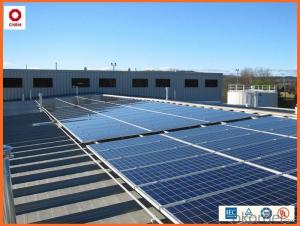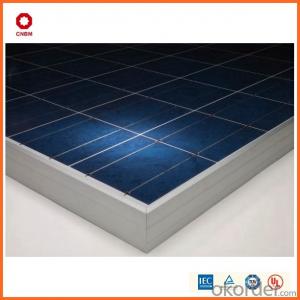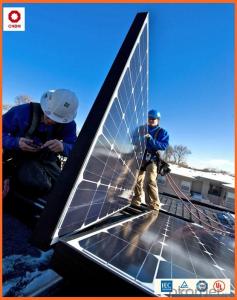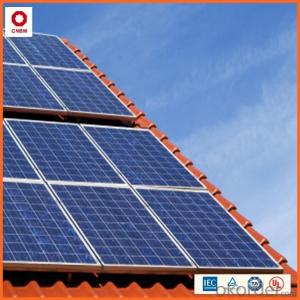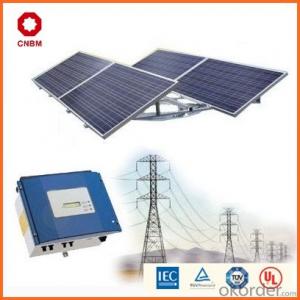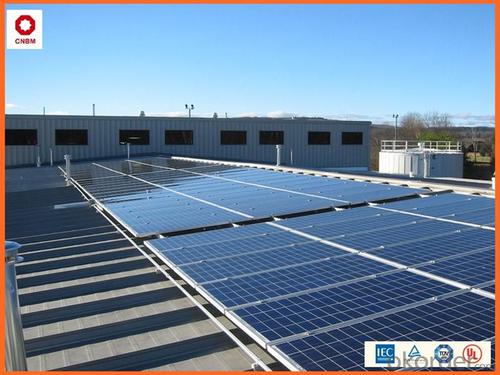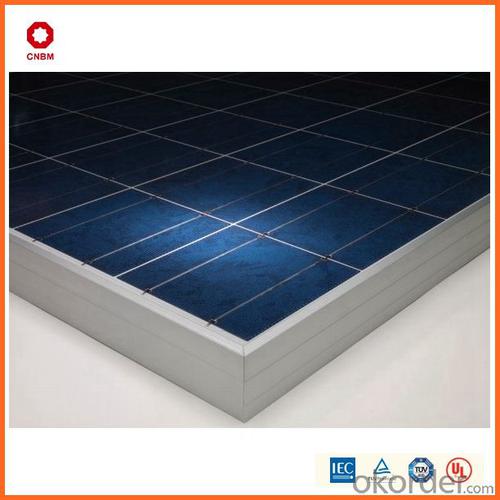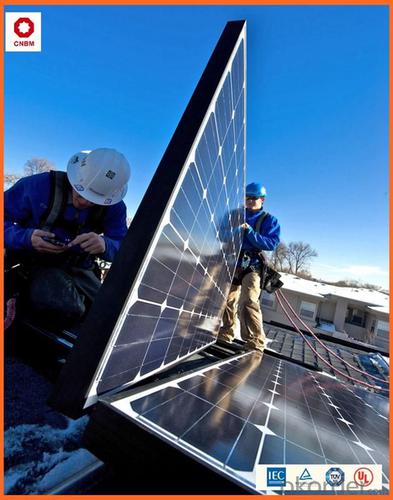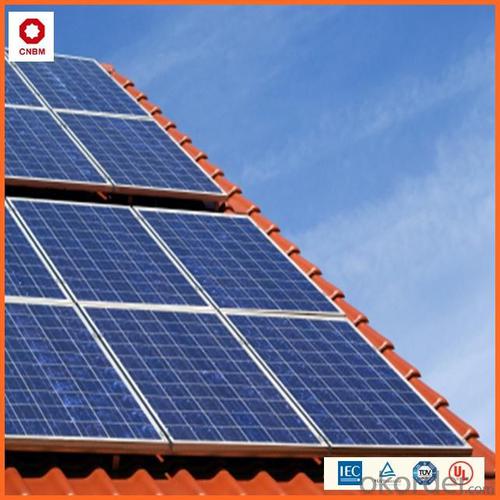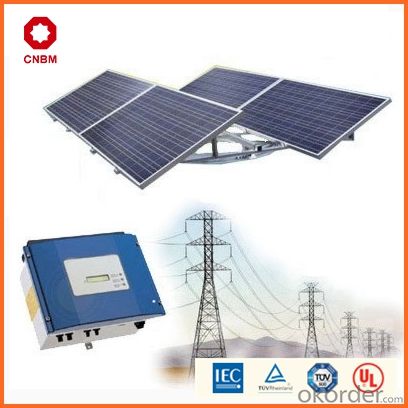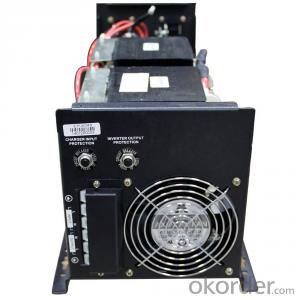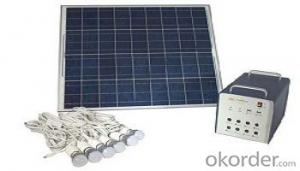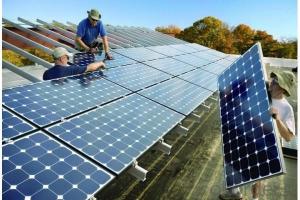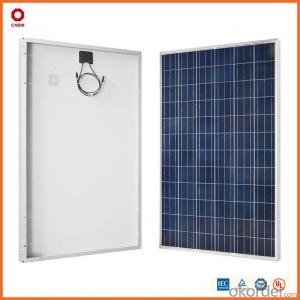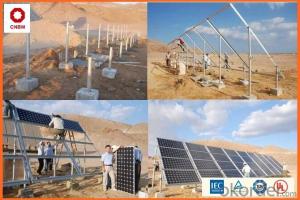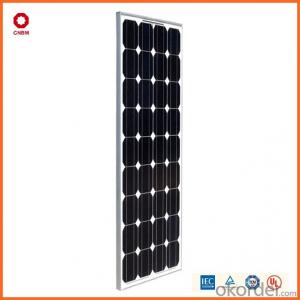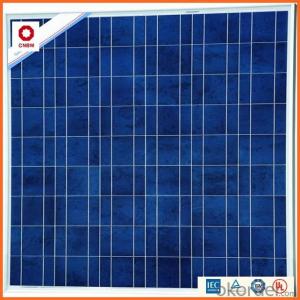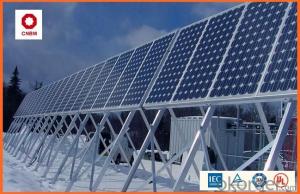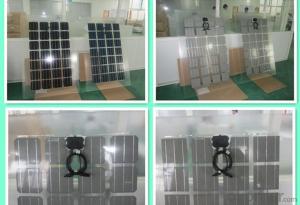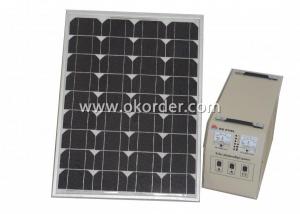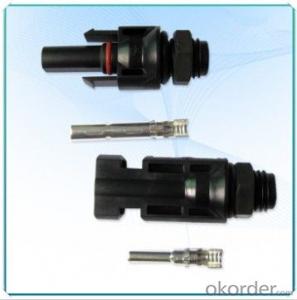Sol Sierra Solar Energy Systems - 55w Small Solar Panels in Stock China Manufacturer
- Loading Port:
- China main port
- Payment Terms:
- TT OR LC
- Min Order Qty:
- 1 watt
- Supply Capability:
- 10000000 watt/month
OKorder Service Pledge
OKorder Financial Service
You Might Also Like
Specification
Product Description:
Hot Sale !!! Quality and Safety of Small Poly Solar Panel 5w~150w
1. Rigorous quality control meets the highest international standards.
2. High-transmissivity low-iron tempered glass, strong aluminium frame.
3. Using UV-resistant silicon.
4. IS09001/14001/CE/TUV/UL
Warranties of Small Poly Solar Panel 35~85w
1. 10 years limited product warranty
2. 15 years at 90% of the minimal rated power output
3. 25 years at 80% of the minimal rated power output
Specification
Characteristics of Poly solar panels CNBM (245-320W) | |||||
Max Power Voltage Vmp(V) | 30.3 | 30.8 | 31.1 | 31.4 | 31.85 |
Max Power Current Imp(A) | 7.60 | 7.64 | 7.73 | 7.81 | 7.85 |
Open Circuit Voltage Voc(V) | 36.1 | 36.6 | 37 | 37.3 | 37.68 |
Short Circuit Current Isc(A) | 8.50 | 8.55 | 8.65 | 8.75 | 8.85 |
Max Power Pm(W) | 230W | 235W | 240W | 245W | 250W |
Temperature Coefficient of Cells Poly solar panels CNBM (245-320W) | |
NOCT | 45± 2 |
Temperature Coeffucients of Isc | 0.0492 |
Temperature Coeffucients of Voc | -0.3374 |
Temperature Coeffucients of Voc | -0.4677 |
Mechanical Data of Poly solar panels CNBM (245-320W) | |
Dimension | 1638 × 982 × 40 mm |
Weight | 19.5 kg |
No. of Cells and Connections | 60 (6 ×10) |
Tolerance | 0 ~ + 5 W |
Cell | Monocrystalline Cell 156 × 156 mm |
Packing | 624 Pcs/40ft(H) Container |
Limits of Poly solar panels CNBM (245-320W) | |
Operating Temperature | -40 to +85 |
Storage Temperature | -40 to +85 |
Max System Voltage | 1000VDC(IEC) / 600VDC(UL) |
Features of our products:
• High conversion efficiency mono/poly-crystalline amorphous silicon solar cells
• Modules incorporate high performance bypass diodes to minimize the power drop caused by shading
• High transmittance, low-iron tempered glass
• High performance EVA encapsulant to prevent destroying and water.
• AI frame: without screw, corner connection. 8 holes on the frame can be installed easily
• Good performance of preventing from atrocious weather such as wind and hails
• Certifications: CE IEC TUV VDE UL, Class I
• 10 years 90% power output warranty
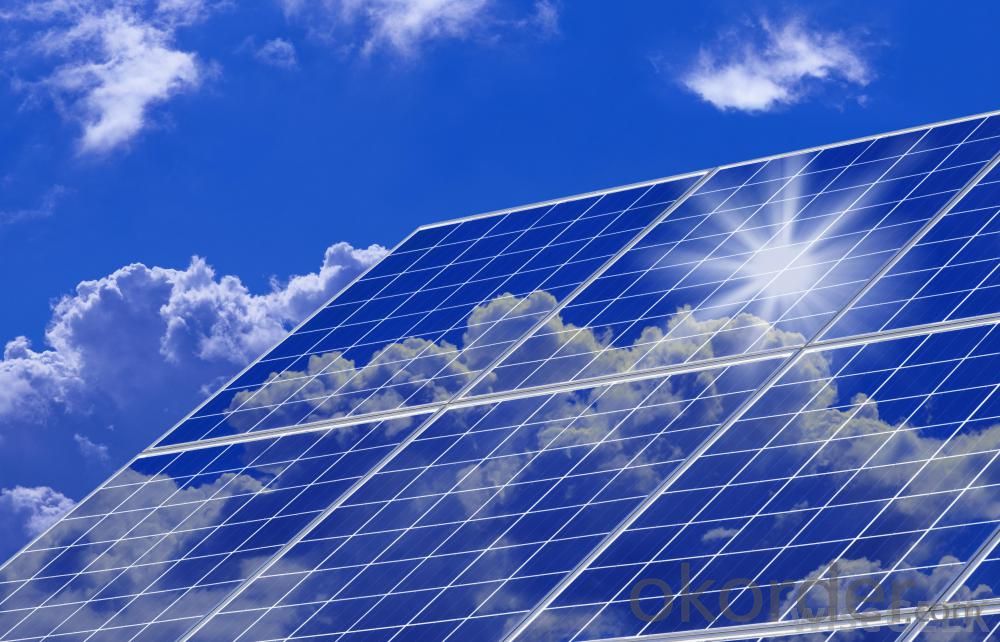
Shipping of Small Poly Solar Panel 35~85w
By Sea | Delivery from Shanghai or Ningbo seaport |
By Air | Departure from Shanghai Pudong Airport |
By Express | Post by DHL, EMS, UPS, TNT. |
Features of our products:
• High conversion efficiency mono/poly-crystalline amorphous silicon solar cells
• Modules incorporate high performance bypass diodes to minimize the power drop caused by shading
• High transmittance, low-iron tempered glass
• High performance EVA encapsulant to prevent destroying and water.
• AI frame: without screw, corner connection. 8 holes on the frame can be installed easily
• Good performance of preventing from atrocious weather such as wind and hails
• Certifications: CE IEC TUV VDE UL, Class I
• 10 years 90% power output warranty
As a professional Solar Panel manufacturer and Supplier in China, we have our customers come around the whole world and our specialization has got a worldwide recognition. Meanwhile, with our superior quality, competitive price, prompt and excellent service, As main role in trade section of CNBM Group, CNBM International Corporation supplies products including Monocrystalline Solar Panel, Polycrystalline Solar Panel ( multicrystalline silicon Solar Panel) have received and enjoyed famous reputation in many countries and regions in the world.
- Q: How does the installation of solar panels affect the building's resale value?
- The installation of solar panels can have a positive impact on a building's resale value. Solar panels are seen as a valuable addition to a property as they provide several benefits. Firstly, solar panels can significantly reduce or even eliminate electricity bills, which is an attractive feature for potential buyers. The prospect of saving money on energy costs can make a property more appealing and increase its market value. Additionally, with rising concerns about climate change and a growing interest in sustainable living, having solar panels can be seen as a desirable feature that aligns with eco-conscious values. Moreover, solar panels can also generate income through net metering programs. In some regions, excess electricity generated by solar panels can be sold back to the grid, providing an additional revenue stream. This financial benefit can make a property more valuable and attract buyers who are interested in renewable energy investments. Furthermore, the installation of solar panels can contribute to a building's overall energy efficiency. This can lead to improved energy performance ratings and certifications, such as LEED or Energy Star, which can further enhance the property's resale value. However, it is important to note that the impact on resale value may vary depending on various factors, including the location of the property, local housing market trends, and the size and quality of the solar panel system. It is advisable to consult with real estate professionals or appraisers who have experience in evaluating the impact of solar panels on property values in a specific area.
- Q: Can a solar energy system be installed on a flat roof?
- Yes, a solar energy system can be installed on a flat roof. In fact, flat roofs are often considered ideal for solar panel installations due to their ease of access and unobstructed sunlight exposure. Flat roofs provide a relatively straightforward installation process as the panels can be mounted directly on the surface without the need for additional structural modifications. Additionally, the orientation and tilt of the solar panels can be optimized to maximize energy production. However, it is important to consider factors such as the load-bearing capacity of the roof, available space, and potential shading issues when planning the installation. Consulting with a professional solar installer or engineer can help ensure a successful installation on a flat roof.
- Q: Are there any health benefits associated with using solar energy?
- Yes, there are several health benefits associated with using solar energy. Firstly, solar energy helps reduce air pollution by replacing fossil fuels as a source of electricity generation, thus decreasing the emissions of harmful pollutants and greenhouse gases. This leads to improved air quality, which can reduce respiratory and cardiovascular health issues. Additionally, solar energy systems do not produce noise pollution, unlike some traditional power generation methods, which can contribute to a healthier and more peaceful environment. Finally, using solar energy reduces reliance on non-renewable resources, promoting sustainable development and long-term health benefits for future generations.
- Q: Can solar energy systems be used in areas with strict environmental regulations?
- Yes, solar energy systems can certainly be used in areas with strict environmental regulations. In fact, solar energy is often encouraged and promoted in such regions due to its clean and renewable nature. Solar systems produce electricity without emitting harmful greenhouse gases or pollutants, making them a favorable option for environmentally conscious communities. Additionally, solar energy systems can be easily integrated into existing structures or built as standalone installations, allowing for flexibility in meeting regulatory requirements.
- Q: Can solar energy systems be used for powering signs or billboards?
- Yes, solar energy systems can be used to power signs or billboards. Solar panels can be installed on or near the signs to capture sunlight and convert it into electricity, which can then be used to power the signs. This is a sustainable and environmentally friendly solution as it reduces reliance on traditional energy sources and reduces carbon emissions. Additionally, solar-powered signs can be installed in remote locations where accessing grid electricity may be difficult or expensive.
- Q: Can solar energy systems be used in areas with limited access to technical expertise?
- Yes, solar energy systems can be used in areas with limited access to technical expertise. The design and installation of solar energy systems have become increasingly user-friendly and accessible over time. There are now simplified and plug-and-play solar kits available that can be easily installed and maintained by individuals with limited technical knowledge. Additionally, organizations and initiatives are providing training and educational resources to empower local communities in these areas to adopt and manage solar energy systems effectively.
- Q: Can solar energy systems be used for powering manufacturing facilities?
- Manufacturing facilities can definitely employ solar energy systems to power their operations. In fact, many manufacturing facilities worldwide are already taking advantage of solar energy to fulfill their power needs. Installing solar energy systems, like photovoltaic (PV) panels, on the roofs or surrounding areas of manufacturing facilities allows for the generation of clean and renewable electricity. This electricity can then be used to operate various processes and equipment within the facility. There are several advantages associated with using solar energy systems for manufacturing facilities. Firstly, solar energy is a sustainable and renewable power source that does not deplete natural resources or contribute to climate change. By utilizing solar power, manufacturing facilities can significantly reduce their carbon footprint and contribute to a greener and more sustainable future. Secondly, solar energy systems provide a consistent and reliable source of electricity, which is crucial for manufacturing facilities that require uninterrupted power supply for their operations. By generating their own electricity through solar power, these facilities can reduce their dependence on the grid and avoid potential disruptions or outages. Moreover, solar energy systems help manufacturing facilities save on energy costs in the long run. While the installation costs of solar panels may initially be high, the operational costs are significantly lower compared to traditional energy sources. Once the solar energy system is in place, the facility can benefit from free sunlight, leading to savings on electricity bills over time. It is important to note that the feasibility of using solar energy systems for manufacturing facilities may vary depending on factors such as the facility's size, available space for solar panel installation, and energy requirements of manufacturing processes. However, advancements in solar technology and decreasing costs of solar panels are making it increasingly economically viable and environmentally responsible for more manufacturing facilities to switch to solar energy systems. In conclusion, solar energy systems can effectively power manufacturing facilities, offering various benefits including sustainability, reliability, and cost savings. As the world moves towards a cleaner and more sustainable energy future, solar power presents a compelling solution for manufacturing facilities seeking to reduce their environmental impact while maintaining a dependable source of electricity.
- Q: What is the impact of solar energy systems on air quality?
- Solar energy systems have a positive impact on air quality as they produce electricity without emitting harmful pollutants or greenhouse gases. By reducing the reliance on fossil fuels, solar energy helps to mitigate air pollution, improve public health, and combat climate change.
- Q: How do solar energy systems impact the transportation sector?
- Solar energy systems have a positive impact on the transportation sector by reducing reliance on fossil fuels. Solar-powered charging stations for electric vehicles (EVs) provide a clean and sustainable energy source, reducing greenhouse gas emissions and dependence on oil. Additionally, solar panels can be installed on vehicles themselves, increasing their range and reducing the need for frequent recharging. Overall, solar energy systems play a crucial role in promoting more sustainable and environmentally friendly transportation options.
- Q: Can solar energy systems be integrated with other energy sources?
- Integrating solar energy systems with other energy sources is a widely adopted approach in various applications to guarantee a dependable and steady provision of electricity. Given that solar energy is intermittent and reliant on sunlight availability, combining solar energy systems with alternative sources, such as batteries or the power grid, facilitates the storage of surplus energy generated during sunny periods and enables the provision of electricity during sunlight scarcity. A prevalent method of integration involves the use of hybrid systems, where solar panels are amalgamated with other renewable energy sources like wind or hydroelectric power. This integration allows for a more consistent and reliable energy supply since the different sources can compensate for fluctuations in one another. Moreover, solar energy systems can be integrated with traditional energy sources like natural gas or coal-based power plants. This integration contributes to the reduction of carbon emissions and aids in the shift towards a cleaner and more sustainable energy mix. By combining solar energy with other sources, the overall energy generation capacity is augmented, resulting in a more stable and secure energy supply. In conclusion, integrating solar energy systems with other energy sources is a pragmatic and efficient approach to maximize the advantages of renewable energy while ensuring a continuous and dependable electricity supply.
Send your message to us
Sol Sierra Solar Energy Systems - 55w Small Solar Panels in Stock China Manufacturer
- Loading Port:
- China main port
- Payment Terms:
- TT OR LC
- Min Order Qty:
- 1 watt
- Supply Capability:
- 10000000 watt/month
OKorder Service Pledge
OKorder Financial Service
Similar products
Hot products
Hot Searches
Related keywords
